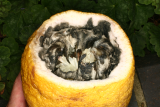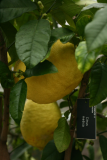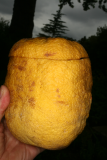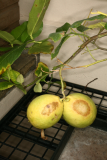Additional notes (click to expand)
Horticulture
Originating in India it came via Persia to Palestine, as pollen grains have been found in a Royal Persian garden in Ramat Rahel near Jerusalem dated to 400-500 BCE, From there it spread across the Mediterranean basin.
It is one of the ancestral species of the genus Citrus, with the Pomelo and the Mandarin, and its genes are present in all modern domesticated Citrus. The lemon, lime and pomelo reached the Mediterranean during the Muslim conquest in the 7th century CE and the orange and mandarin in the past 200years. C. medica is mentioned by Theophrastus in his 'Enquiry into Plants' (circa 360 BCE) as the 'Median' or 'Persian' apple growing in Persia.
Dafna Langgut 'Prestigious fruit trees in ancient Israel: first palynological evidence for growing ... Citrus medica' http://dx.doi.org/10.1080/07929978.2014.950067
link
Medicinal
Citrus medica peel is the source of citron oil
Van Wyk, Wink, BE . (2017). Medicinal Plants of the World. CABI.
Nomenclature
The 'Median' or 'Persian' apple of Theophrastus. From the land of the Medes, hence C. medica.
Theophrastus (translated by Hort, AF). (1980). Enquiry into Plants, Harvard, Heineman. Goold, GP
Curiously, in illustrated books, such as the herbals, from the 16th until the mid-19th century, the name Citrus medica was given to Citrus limon, and despite the obvious difference in size, the two names, and the plants, were regarded as synonymous.
Oakeley H F 'Citrus x limon. Lemons are hybrids' essay server
Other use
Culinary use. Innumerable recipes can be found for candied peel
rages.Referred to as Etrogs in the Jewish tradition, the fruit is grown for ritual use in the Sukkot harvest festival, held in September or October. Many Jewish people believe that this is “the fruit of a goodly tree” mentioned in Leviticus 23:40: “And you shall take of yourselves on the first day the fruit of a goodly tree, a palm branch, the myrtle branch, and the willow of the brook; and you shall rejoice before the Lord your God seven days.”
Fruit intended for ritual use must come from trees grown on their own roots, from seeds or cuttings, i.e. not be grafted on rootstock like most other citrus. The fruit trees must descend from parent stock known or believed to have never been grafted. Beautiful, shapely and unblemished fruit may be highly prized amongst observant Jews, selling for $100 or more.
Blemished specimens, and fruits from grafted trees, are sometimes sold for culinary use. The rind is used to make preserves, and as a flavoring ingredient for savory dishes, desserts and alcoholic beverages
University of California Riverside, Citrus variety database. Accessed 2017 http://www.citrusvariety.ucr.edu/citrus/ethrog.html
link
Geographical distribution
- Asia-Tropical, Indian Subcontinent, India
Citrus medica L.
Family: RUTACEAEGenus: Citrus
Species: medica L.
Common names: Citron, Etrog
Pharmacopoeia Londinensis name: Citrium malum
Distribution summary: possible origin N.E. India & China
Habit: Tree
Hardiness: H2 - Tender; cool or frost-free greenhouse
Habitat: montane tropical evergreen forest
Garden status: Currently grown
Garden location: Plants in pots (POT)
Flowering months: January, December
Reason for growing: Medicinal, other use
.JPG)
.JPG)

.JPG)
.JPG)
.JPG)
.JPG)



.JPG)
.JPG)


.JPG)